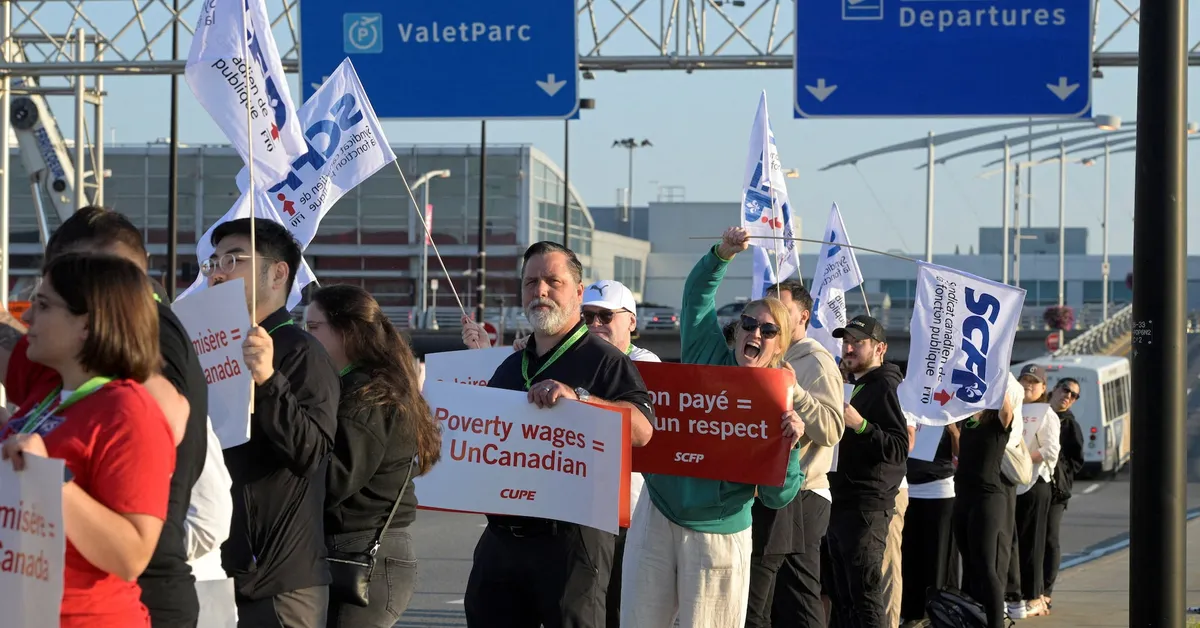
The recent strike, which commenced just before 1 a.m. EDT (0500 GMT), has significantly disrupted operations at Air Canada, the country's largest airline. This labor action has led to the suspension of the majority of the airline's 700 daily flights, impacting over 100,000 travelers who now face the challenge of securing alternative travel arrangements or remaining stranded.
As of Saturday morning, no bargaining sessions were scheduled between the airline and the Canadian Union of Public Employees (CUPE), which represents more than 10,000 flight attendants. This strike marks the first such action taken by Air Canada flight attendants since 1985, highlighting the seriousness of the current labor dispute.
Outside Toronto Pearson International Airport, which is Canada's busiest airport, hundreds of cabin crew members gathered, waving flags, banners, and picket signs to voice their concerns. Union officials have urged members to assemble at all major airports across the country, including those in Montreal, Calgary, and Vancouver.
According to Montreal-based Air Canada, the suspended flights also include those operated by its budget airline, Air Canada Rouge. The airline stated that the stoppage will affect approximately 130,000 customers daily. However, flights operated by Air Canada's regional affiliates, such as Air Canada Jazz and PAL Airlines, will continue to operate as scheduled.
Air Canada has advised customers impacted by the strike not to head to the airport unless they possess a confirmed ticket with another airline besides Air Canada or Air Canada Rouge. This precaution aims to minimize confusion and ensure that travelers have alternative plans in place.
The core issue fueling the labor dispute between the union and Air Canada revolves around wages. Currently, flight attendants are compensated only for the time their planes are in motion. The union is advocating for pay for the time spent on the ground between flights as well as during the boarding process.
The union has reported that Air Canada proposed compensating flight attendants for some previously unpaid work, but only at 50% of their hourly rate. Additionally, the airline offered a 38% increase in total compensation over a four-year period, including a 25% raise in the first year, which the union has deemed insufficient.
The ramifications of this strike extend beyond just the airline itself, as Air Canada is the busiest foreign carrier servicing the U.S. in terms of scheduled flights. While passengers have shown general support for the flight attendants on social media, Canadian businesses—already affected by ongoing trade disputes with the U.S.—are urging the federal government to intervene and impose binding arbitration to resolve the conflict swiftly.
The Canada Labour Code allows Jobs Minister Patty Hajdu to request the country's Industrial Relations Board to impose binding arbitration in the interest of protecting the economy. In contrast, Air Canada has appealed to Prime Minister Mark Carney's minority Liberal government for action, but the union insists on negotiating a resolution, as binding arbitration would relieve pressure from the airline.
Minister Hajdu has consistently encouraged both parties to return to the bargaining table to reach a mutually agreeable solution. In a recent note to clients, analysts from financial services firm TD Cowen advised Air Canada to extend an olive branch to resolve this impasse. They noted that investors are concerned that any potential cost savings in labor could be overshadowed by lost earnings during the airline's critical financial quarter. In their words, "We think it would be best for AC to achieve labor peace," emphasizing that failure to negotiate could lead to detrimental consequences.
This ongoing strike by Air Canada flight attendants presents a significant challenge not only for the airline but also for its passengers and the broader Canadian economy. As the situation develops, the hope remains for a timely resolution that satisfies both the union's demands and the airline's operational needs.